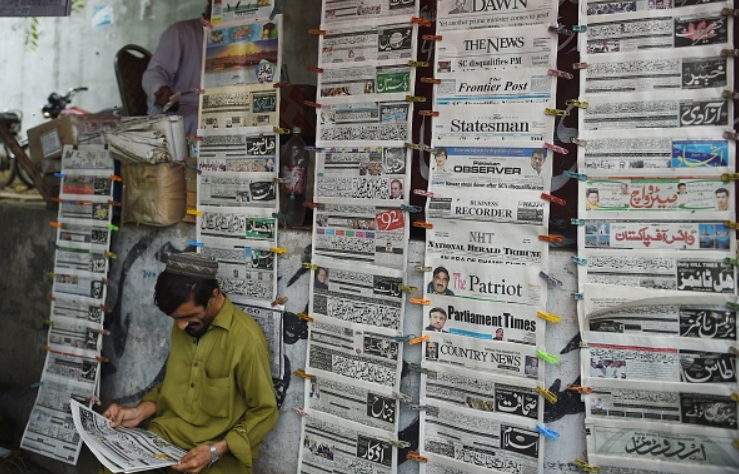Last month, Pakistani police charged former Prime Minister Imran Khan under the anti-terrorism act, in addition to placing a sweeping ban on live telecasts of his speeches. The charge comes after Khan vowed to sue police officers and a judge over the alleged torture Shehbaz Gill, his close aide, who is in police custody on sedition charges. However, as the current administration looks to stamp out Imran Khan’s continued street power, media freedom appears to be the primary casualty.
Over the past two decades, Pakistan has produced a relatively vibrant media sector that represents a diversity of political views and opinions. However, in recent years, subsequent governments and the military establishment alike have curtailed media freedom in ways that threaten pluralism and journalistic independence in the country. This has been done by drawing new “red lines” against unpalatable issues. Previously, this practice of silencing the media was limited mostly to the peripheries of the country. The case of the Pashtun Tahafuz Movement (PTM) is perhaps the most notable, where reporters have been told to “lie low” in their reporting to not contradict the official narrative. However, the latest trends in curtailing media freedom have been increasingly concentrated in major cities, becoming more set under Pakistan Muslim League-Nawaz (PML-N) party from 2013 to 2018 and Pakistan Tehreek-e-Insaf (PTI) from 2018 to 2022.
With the growing polarization of both domestic politics and the media space in Pakistan, the arbitrary and political use of power by successive governments to stifle political dissent and weaken the opposition has come at a greater cost to media freedom and democracy in the country. With each party in power seeking to benefit from media restrictions, this trend shows little signs of change.
Track Record of Media Freedom under PML-N and PTI
In the past decade, limiting the press has been done using different means including new legal mechanisms, physical coercion, violence against journalists, and media blackouts. While politicians may promise to improve press freedoms out of office, the press environment has continued to weaken over successive administrations. For instance, the PML-N promised to enact a journalists’ protection law in its 2013 election manifesto but this remained on hold throughout its tenure until 2018. Instead, in 2016, Pakistan’s National Assembly approved the Prevention of Electronic Crimes Bill (2015), which allowed for “sweeping censorship of the internet” and was criticized especially for giving substantial power and discretion to enforcement agencies. That same year, Pakistan was ranked among the 10 worst countries for internet freedom and fourth among the 10 worst countries for journalists. 157 attacks on journalists were reported between May 2017 and April 2018 during the last years of the PML-N tenure. Earlier, there were also armed attacks on senior journalists Hamid Mir in 2014 and Cyril Almeida in 2016. Almeida was “barred from leaving the country” following his report on a civil-military row in what famously became known as the “Dawn Leaks.”
With the growing polarization of both domestic politics and the media space in Pakistan, the arbitrary and political use of power by successive governments to stifle political dissent and weaken the opposition has come at a greater cost to media freedom and democracy in the country.
Similarly, despite promises during Imran Khan’s campaign for Prime Minister on greater press freedoms, the PTI government took a different turn once in office. It extended media regulation to digital media and proposed the formation of Pakistan Media Development Authority (PMDA) in May 2021. Rejected across the media industry, the PMDA threatened digital media freedom and public-interest journalism in the country.
The PTI’s rhetoric also set a dangerous framing of the relationship between media and politics. In July 2019, the PTI official Twitter account linked critical media coverage as potential “treason” and Imran Khan later referred to criticisms of the state’s of press freedom in Pakistan as “a joke”. In 2021, Reporters Without Borders (RSF) termed Khan a “predator” under whose government, Pakistan was “reliving some of the worst moments of its past military dictatorship.”
In the last year of the PTI government, Pakistan registered a steep decline of 12 points on the World Press Freedom Index (2022), with at least 86 cases of attacks on media persons between April 2021 and May 2022, with state actors said to be the largest source of threats.
The Still Shrinking Space for Dissent
Like other administrations before it, the PML-N-led coalition government initially promised press reforms and announced its intentions to “disband” the PMDA as Prime Minister Shehbaz Sharif boasted his commitment to “freedom of press and speech.” However, despite these bold promises, press freedom thus far has only appeared to deteriorate further. This time, journalists subscribing to the PTI narrative of “regime change” are at the receiving end of censorship and violence.
Media censorship and stifling dissent, which reached new heights under Imran Khan, have now returned to haunt his supporters after his ouster. On July 5, a prominent pro-PTI journalist Imran Riaz Khan was detained for 17 treason charges. Just a week earlier, Ayaz Mir, a senior journalist, was physically assaulted by “unidentified men” for criticizing the military establishment. This set in motion a series of events where the government has been targeting pro-PTI journalists and media houses. More recently on August 12, the government revoked the operating license of ARY News for broadcasting “seditious content” during an interview with Shehbaz Gill, the PTI’s Chief of Staff, and launched an investigation of ARY CEO Salman Iqbal and other journalists after the controversial remarks. The Pakistan People’s Party (PPP) Senator Farhat Ullah Babar expressed his concern over the lack of due process in action against ARY News, saying that “using state power arbitrarily will backfire.”

